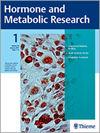Association Between HLA-DRB1 Alleles and Gravesʼ Disease in Asian Populations: A Meta-Analysis
IF 2
4区 医学
Q3 ENDOCRINOLOGY & METABOLISM
引用次数: 0
Abstract
Graves’ disease (GD) is an autoimmune disease that primarily affects the thyroid gland. It is the most common cause of hyperthyroidism. Genetic studies have shown that human leukocyte antigen (HLA) plays an important role in the development of GD. In this article, we performed a meta-analysis determined to evaluate the relationship between HLA-DRB1 alleles and GD. This meta-analysis included 9 studies (3582 cases in the case group and 23070 cases in the control group) and 27 alleles was performed. The combined results showed that, compared with the control group, GD patients have a significant increase in the frequency of DRB1*1403 (OR=2.50, 95% CI=1.78–3.51, pc<0.0001) and have a significant decrease in frequencies of DRB1* 0101 (OR=0.45, 95% CI=0.34–0.59, pc<0.0001) and DRB1*0701 (OR=0.44, 95% CI=0.35–0.55, pc<0.0001). The meta-analysis indicated that, in Asian populations, DRB1*1403 is a risk allele for GD, and DRB1*0101 and DRB1*0701 are protective against the occurrence of GD. We surprisingly discovered that the susceptibility alleles for GD in Asian populations are completely different from Caucasians and the protective alleles for GD in Asians are quite similar to those of Caucasians. The results of our study may provide new opportunities for gene-targeted therapy for GD in Asian populations.亚洲人群中 HLA-DRB1 等位基因与巴塞杜氏病的关系:元分析
巴塞杜氏病(GD)是一种主要影响甲状腺的自身免疫性疾病。它是甲状腺功能亢进症最常见的病因。遗传学研究表明,人类白细胞抗原(HLA)在巴塞杜氏病的发病中起着重要作用。在本文中,我们进行了一项荟萃分析,旨在评估HLA-DRB1等位基因与GD之间的关系。这项荟萃分析包括 9 项研究(病例组 3582 例,对照组 23070 例)和 27 个等位基因。综合结果显示,与对照组相比,GD 患者的 DRB1*1403 频率显著增加(OR=2.50,95% CI=1.78-3.51,pc<0.0001),DRB1*0101(OR=0.45,95% CI=0.34-0.59,pc<0.0001)和 DRB1*0701 (OR=0.44,95% CI=0.35-0.55,pc<0.0001)频率显著降低。荟萃分析表明,在亚洲人群中,DRB1*1403是GD的风险等位基因,而DRB1*0101和DRB1*0701对GD的发生具有保护作用。我们惊讶地发现,亚洲人的广东话易感等位基因与白种人完全不同,而亚洲人的广东话保护性等位基因与白种人十分相似。我们的研究结果可能会为亚洲人的 GD 基因靶向治疗提供新的机会。
本文章由计算机程序翻译,如有差异,请以英文原文为准。
求助全文
约1分钟内获得全文
求助全文
来源期刊

Hormone and Metabolic Research
医学-内分泌学与代谢
CiteScore
3.80
自引率
0.00%
发文量
125
审稿时长
3-8 weeks
期刊介绍:
Covering the fields of endocrinology and metabolism from both, a clinical and basic science perspective, this well regarded journal publishes original articles, and short communications on cutting edge topics.
Speedy publication time is given high priority, ensuring that endocrinologists worldwide get timely, fast-breaking information as it happens.
Hormone and Metabolic Research presents reviews, original papers, and short communications, and includes a section on Innovative Methods. With a preference for experimental over observational studies, this journal disseminates new and reliable experimental data from across the field of endocrinology and metabolism to researchers, scientists and doctors world-wide.
 求助内容:
求助内容: 应助结果提醒方式:
应助结果提醒方式:


